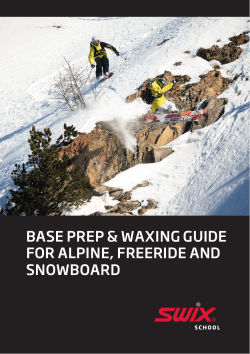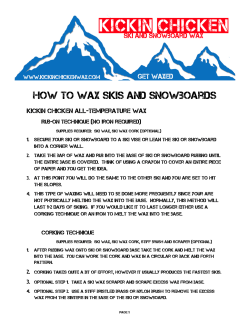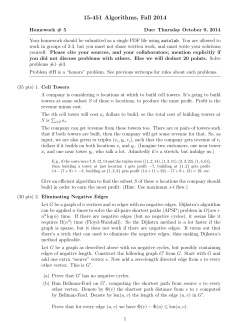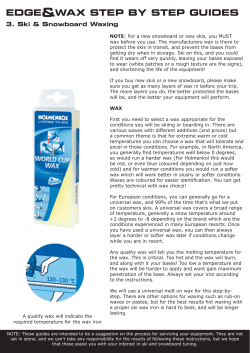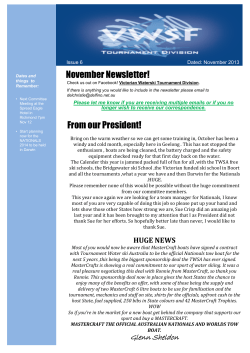
ders eational Skiers and Snowboar ecr e R
E 827 PR0 ders boar w o Sn and s r e Ski onal i t a ecre ve R i t c A For Alpine ski and snowboard preparation ACTIVE RECREATION USER LEVEL Although you might only use your equipment occasionally during the season, you should still expect good performance from your skis or board to make the experience fun, safe, and confidence building. With just a few simple maintenance steps you can achieve the best from your equipment. These tuning steps can be accomplished at home, in the ski area parking lot, or even on the hill. Ski control is improved, and skiing will actually be less tiring. More fun! TREATMENT OF STEEL EDGES AND BASES WITH SWIX PRODUCTS Sharp edges are like new tires for the car. You feel more secure and confident. The equipment will respond more precisely to your skiing and riding movements, especially when the snow is hard. When it comes to smooth gliding, unwaxed skis and boards can be compared to bicycling with not enough air in the tires. The Universal Glide Wax gives smoother turns with less effort, more glide on the flats, and in general a better experience. Recommended products: TA3001 Base-edge and Side-edge tool with file. F4-150 Universal liquid wax. Fluorinated for better glide I62 Base Cleaner. R392 Ski Straps with base protector. T240 Stone for polishing the edges. F4-60 Universal crayon solid wax. Fluorinated for better glide. T151 Fiberlene cleaning and polishing paper. T165 Ski Brake Retainer. Let’s do edges Filing the edges First step in prepping your skis or board is to start with the edges. Doing the edges first will avoid getting wax in the file. For optimal carving the edges need to be sharp and smooth (no burrs). Treatment of edges is divided into 2 areas: BASE-EDGE: SIDE-EDGE Sidewall Ski/Snowboard Steel edge Base material Ski/Snowboard Steel edge Base material 1.0° 0.5° Generally 0.5 to 1 degree bevel. Generally 88 to 89 degree bevel. 1. Base-edge: Start with the base-edge using the TA3001. Put the file holder in the 1 degree position. (See illustration.) If not using a vise, support the ski or the board against the body. Move the file holder towards you with overlapping movements working from the middle of the ski or board. Turn the ski or board around and repeat. TA3001 Base-edge filing 2. Side-edge: The side-edges can also be done with theTA3001. Set the file in the 88 degree position (2 degree bevel for the side edge.) (See illustration.) Support the ski or the board against your body. If you are right handed the base should be facing away from you. Move the file holder towards you with overlapping movements. Turn the ski around and repeat. á Side-edge filing 3. Polishing the edges: Like sharpening knives it is not necessary to use a file every time you need to tune the edges. Use the fine (brown) side of the T240 Stone. Work the stone back and forth along the side-edge and then the base-edge for two or three times. This will remove small burrs from filing and also from skiing and riding on icy snow. The edges will now be polished and sharp without irregularities. T240 4. Rounding off edges at the tip and tail: Some prefer to detune the edges slightly at the tip and tail to avoid erratic response from the skis or board. If you feel the skis or the board is hard to handle in the turns (overturning or hooking), or handles erratically on the straights, you should dull (or round-off) the edges on both sides of the tip approximately 20 to 25 cm (6 to 8 inches) with the coarse (grey) side of the T240 Stone. Also dull the tail section approximately 5 cm (2 inches). For boards dull the tip and tail section approximately 20 to 25 cm (6 to 8 inches) (see illustration). T240 5. Removing damaged spots on the edges: To maintain good carving characteristics the edges must be even and smooth without rough spots usually caused from hitting rocks. When rocks are hit there is a burst of heat that hardens the steel. When you start filing you will find that the file skids over these spots without cutting the steel. To remove the hardened steel you use the coarse (grey) side of the T240 Stone. Wet it in the snow, and “scrub” the damaged spots back and forth on both the side-edge and base-edge if necessary. (See illustration.) Follow with TA3001 File Guide on both base- and side-edge. Now you will feel that the file is doing its job. Finish by polishing with the fine side of the T240 Stone. á 6. Cleaning the base: Spray the base with I62 Base Cleaner and wipe off with the T151 Fiberlene Paper after approximately 15 seconds. I62 T151 FINCH Photo: Matt Power Waxing skis and snowboards Swix F4 Universal Fluorinated Glide Wax Swix F4 is a universal glide wax with a wide temperature range for all snow conditions. Swix F4 comes in liquid, paste, or solid form. Most used are F4-150 liquid wax and F4-60 solid wax. Swix F4 waxes are fluorinated for better glide. “Bad glide is like bicycling without air in the tires.” Waxing gives you better control, and smoother turning with less effort. And, nobody likes to be slow on the flats. Waxing also helps prevent base oxidation (dried out bases). HOW TO APPLY: “LIQUID METHOD” • Shake the F4-150 container and then press the base to release some wax. Apply evenly. (See illustration.) • Wait a couple of minutes before setting the base on the snow. For optimal performance polish with T151 Fiberlene Paper. Just like you polish your shoes. F4-150 T151 HOW TO APPLY: “DRY METHOD” • F4-60 solid wax is crayoned, or rubbed dry, onto the base. (See illustration.) • F4-60 solid wax should be polished with the cork on the back of the package. F4-60 NOTE: Generally liquid wax does not last as long as wax that is applied dry and corked. A DIRTY BASE IS A SLOW BASE - KEEP IT CLEAN! I62 T151 Swix School is a web-based instructional site showing ski and snowboard preparation. Through film, graphic illustrations, and sound, you can learn how to treat your equipment according to your technical level. Remember: Well prepared skis and boards will give you a better day on the hill! www.swixschool.com
© Copyright 2025
